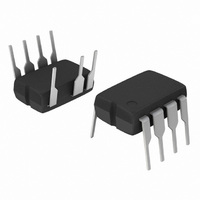NCP1271P100G ON Semiconductor, NCP1271P100G Datasheet - Page 10

NCP1271P100G
Manufacturer Part Number
NCP1271P100G
Description
IC CTRLR PWM CM OVP OTP HV 7DIP
Manufacturer
ON Semiconductor
Series
Soft-Skip™r
Datasheet
1.NCP1271P100G.pdf
(21 pages)
Specifications of NCP1271P100G
Output Isolation
Either
Frequency Range
85 ~ 107kHz
Voltage - Input
9.1 ~ 20 V
Operating Temperature
-40°C ~ 150°C
Package / Case
8-DIP (0.300", 7.62mm), 7 Leads
Number Of Outputs
1
Duty Cycle (max)
80 %
Output Voltage
- 0.3 V to + 20 V
Output Current
800 mA
Mounting Style
Through Hole
Switching Frequency
100 KHz
Maximum Operating Temperature
+ 150 C
Fall Time
20 ns
Minimum Operating Temperature
- 40 C
Rise Time
30 ns
Synchronous Pin
No
Topology
Flyback
Lead Free Status / RoHS Status
Lead free / RoHS Compliant
Available stocks
Company
Part Number
Manufacturer
Quantity
Price
Company:
Part Number:
NCP1271P100G
Manufacturer:
ON Semiconductor
Quantity:
2
Part Number:
NCP1271P100G
Manufacturer:
ON/安森美
Quantity:
20 000
Introduction
fixed−frequency PWM current−mode flyback controllers
from ON Semiconductor. The device features integrated
high−voltage startup and excellent standby performance.
The proprietary Soft−Skip Mode achieves extremely
low−standby power consumption while keeping power
supply acoustic noise to a minimum. The key features of
the NCP1271 are as follows:
•
•
•
•
•
•
•
•
The NCP1271 represents a new generation of the
Timer−Based Fault Detection: In the event that an
abnormally large load is applied to the output for more
than 130 ms, the controller will safely shut the
application down. This allows accurate overload (OL)
or short−circuit (SC) detection which is not dependent
on the auxiliary winding.
Soft−Skip Mode: This proprietary feature of the
NCP1271 minimizes the standby low−frequency
acoustic noise by ramping the peak current envelope
whenever skip is activated.
Adjustable Skip Threshold: This feature allows the
power level at which the application enters skip to be
fully adjusted. Thus, the standby power for various
applications can be optimized. The default skip level
is 1.2 V (40% of the maximum peak current)
500 V High−Voltage Startup Capability: This
AC−DC application friendly feature eliminates the
need for an external startup biasing circuit, minimizes
the standby power loss, and saves printed circuit board
(PCB) space.
Dual High−Voltage Startup−Current Levels: The
NCP1271 uniquely provides the ability to reduce the
startup current supply when Vcc is low. This prevents
damage if Vcc is ever shorted to ground. After Vcc
rises above approximately 600 mV, the startup current
increases to its full value and rapidly charges the Vcc
capacitor.
Latched Protection: The NCP1271 provides a pin,
which if pulled high, places the part in a latched off
mode. Therefore, overvoltage (OVP) and
overtemperature (OTP) protection can be easily
implemented. A noise filter is provided on this function
to reduce the chances of falsely triggering the latch. The
latch is released when Vcc is cycled below 4 V.
Non−Latched Protection/ Shutdown Option: By
pulling the feedback pin below the skip threshold
level, a non−latching shutdown mode can be easily
implemented.
4.0 ms Soft−Start: The soft start feature slowly ramps
up the drive duty cycle at startup. This forces the
primary current to also ramp up slowly and
dramatically reduces the stress on power components
during startup.
OPERATING DESCRIPTION
.
http://onsemi.com
10
•
•
•
•
•
NCP1271 Operating Conditions
There are 5 possible operating conditions for the NCP1271:
Current−Mode Operation: The NCP1271 uses
current−mode control which provides better transient
response than voltage−mode control. Current−mode
control also inherently limits the cycle−by−cycle
primary current.
Compensation Ramp: A drawback of current−mode
regulation is that the circuit may become unstable
when the operating duty cycle is too high. The
NCP1271 offers an adjustable compensation ramp to
solve this instability.
80% Maximum Duty Cycle Protection: This feature
limits the maximum on time of the drive to protect the
power MOSFET from being continuously on.
Frequency Jittering: Frequency jittering softens the
EMI signature by spreading out peak energy within a
band +/− 7.5% from the center frequency.
Switching Frequency Options: The NCP1271 is
available in either 65 kHz or 100 kHz fixed frequency
options. Depending on the application, the designer
can pick the right device to help reduce magnetic
switching loss or improve the EMI signature before
reaching the 150 kHz starting point for more
restrictive EMI test limits.
1. Normal Operation – When V
2. Standby Operation (or Skip−Cycle Operation)
3. Fault Operation – When no feedback signal is
(9.1 V typical) and the feedback pin voltage (V
is within the normal operation range (i.e.,V
V), the NCP1271 operates as a fixed−frequency
current−mode PWM controller.
When the load current drops, the compensation
network responds by reducing the primary peak
current. When the peak current reaches the skip
peak current level, the NCP1271 enters Soft−Skip
operation to reduce the power consumption. This
Soft−Skip feature offers a modified peak current
envelope and hence also reduces the risk of audible
noise. In the event of a sudden load increase, the
transient load detector (TLD) disables Soft−Skip
and applies maximum power to bring the output
into regulation as fast as possible.
received for 130 ms or when V
V
as a fault condition. In this fault mode, the Vcc
voltage is forced to go through two cycles of slowly
discharging and charging. This is known as a
“double hiccup.” The double hiccup insures that
ample time is allowed between restarts to prevent
overheating of the power devices. If the fault is
CC(off)
(9.1 V typical), the NCP1271 recognizes it
CC
CC
is above V
drops below
FB
CC(off)
< 3.0
FB
)












